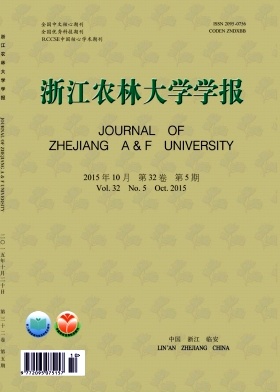| [1] |
TONG Liang, LI Pingheng, ZHOU Guomo, ZHOU Yufeng, LI Chong.
A review of research about rhizome-root system in bamboo forest
. Journal of Zhejiang A&F University,
2019, 36(1): 183-192.
doi: 10.11833/j.issn.2095-0756.2019.01.023
|
| [2] |
WANG Cheng, DONG Bin, PENG Wenjuan, CHEN Lingna, HUANG Hui, YE Xiaokang, ZHU Ming, LÜ Dian, NI Yanhua, ZHAO Kangkang, ZHANG Shuangshuang.
Influence of land-use change on the crane habitat and population in Shengjin Lake Wetland
. Journal of Zhejiang A&F University,
2018, 35(3): 511-518.
doi: 10.11833/j.issn.2095-0756.2018.03.016
|
| [3] |
ZHANG Jie, YIN Dejie, GUAN Haiyan, QU Qiqi, DONG Li.
An overview of Sedum spp. Research
. Journal of Zhejiang A&F University,
2018, 35(6): 1166-1176.
doi: 10.11833/j.issn.2095-0756.2018.06.022
|
| [4] |
WU Xue, DU Changxia, YANG Bingbing, FAN Huaifu.
Research progress in plant aquaporins
. Journal of Zhejiang A&F University,
2015, 32(5): 789-796.
doi: 10.11833/j.issn.2095-0756.2015.05.020
|
| [5] |
YE Lisha, CHEN Shuanglin, GUO Ziwu.
Research on nitrogen circulation and management of bamboo: a review
. Journal of Zhejiang A&F University,
2015, 32(4): 635-642.
doi: 10.11833/j.issn.2095-0756.2015.04.021
|
| [6] |
ZHANG Tao, LI Yongfu, JIANG Peikun, ZHOU Guomo, LIU Juan.
Research progresses in the effect of land-use change on soil carbon pools and soil respiration
. Journal of Zhejiang A&F University,
2013, 30(3): 428-437.
doi: 10.11833/j.issn.2095-0756.2013.03.021
|
| [7] |
FU Jianguo, LIU Jinliang, YANG Xiaojun, AN Yulin, LUO Jiayan.
A review of wood identification based on molecular biology technologies
. Journal of Zhejiang A&F University,
2013, 30(3): 438-443.
doi: 10.11833/j.issn.2095-0756.2013.03.022
|
| [8] |
XU Wenhui, YUE Xiaolei, GAO Peng, XIA Shujuan.
Potential ecological habitat of Muntiacus crinifrons within National Nature Reserve of Mount Tianmu,Zhejiang Province
. Journal of Zhejiang A&F University,
2013, 30(6): 896-903.
doi: 10.11833/j.issn.2095-0756.2013.06.014
|
| [9] |
DU Xue, LI Jinjun, LU Lizhi, ZHAO Ayong.
Research progresses on cholesterol 7α-hydroxylase gene (CYP7A1)
. Journal of Zhejiang A&F University,
2013, 30(5): 755-760.
doi: 10.11833/j.issn.2095-0756.2013.05.019
|
| [10] |
CHENG Jian-zhong, YANG Ping, GUI Ren-yi.
Research progress on speciation of selenium compounds in plants
. Journal of Zhejiang A&F University,
2012, 29(2): 288-395.
doi: 10.11833/j.issn.2095-0756.2012.02.020
|
| [11] |
ZHANG Hui-ling, SONG Xin-zhang, AI Jian-guo, JIANG Hong, YU Shu-quan.
A review of UV-B radiation and its influence on litter decomposition
. Journal of Zhejiang A&F University,
2010, 27(1): 134-142.
doi: 10.11833/j.issn.2095-0756.2010.01.022
|
| [12] |
WANG Hang-jun, ZHANG Guang-qun, QI Heng-nian, LI Wen-zhu.
A review of research on wood recognition technology
. Journal of Zhejiang A&F University,
2009, 26(6): 896-902.
|
| [13] |
GONG Zhi-wen, KANG Xin-gang, GU Li, ZHAO Jun-hui, ZHENG Yan-feng, YANG Hua.
Research methods on natural forest stand structure:a review
. Journal of Zhejiang A&F University,
2009, 26(3): 434-443.
|
| [14] |
SHAO Ji-feng, LU Qing-bin, JIN Jing, YOU Wei-yun, YU Jiang-ao.
Winter feeding site selection of ring-necked pheasants in Mount Qingliangfeng
. Journal of Zhejiang A&F University,
2008, 25(4): 507-512.
|
| [15] |
CAOMing, LI Wei, ZHOUWei, ZHANG Xing-yong, ZHANG Ren-gong.
Foraging sites during the early breeding stage of Syrmaticus humiae in the Nanhua Part of Ailaoshan National Nature Reserve
. Journal of Zhejiang A&F University,
2007, 24(2): 203-208.
|
| [16] |
PANShi-xiu, MEN Xiu-xiang, FENG Jin-chao, ZHOUYi-jun, XUHong-fa.
A review of studies on habitat selection by small and solitary forest ruminants
. Journal of Zhejiang A&F University,
2007, 24(3): 357-362.
|
| [17] |
DAI Jian-bing, YU Yi-wu, CAO Qun.
Summary of research on wetland protection and management
. Journal of Zhejiang A&F University,
2006, 23(3): 328-333.
|
| [18] |
YAN Shao-jun, ZHU Xi, YU Yi-wu.
Construction techniques for the city heronries in Central China
. Journal of Zhejiang A&F University,
2006, 23(6): 697-700.
|
| [19] |
SU Xiu, ZHU Xi.
Progress in research of birdsong
. Journal of Zhejiang A&F University,
2006, 23(3): 323-327.
|
| [20] |
Wu Hong, Fang Zhigang..
Studies on the Insect Fauna of Mount Gutian, Zhejiang.
. Journal of Zhejiang A&F University,
1995, 12(1): 63-72.
|






 DownLoad:
DownLoad: